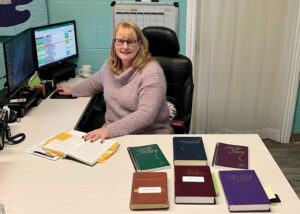When we opened the portal for submissions to Voices Together, the new Mennonite hymnal, the committee received over 2,000 submissions from songwriters, text writers, and composers from around the world, many of whom were Mennonite.
A few years into our process of screening the submissions portal and many other published sources, the committee noticed a glaring imbalance in the gender of contributors, with more pieces by men than by others. To mitigate this imbalance and to elevate the voices of underrepresented contributors, I went through the submissions portal again, giving special attention to pieces by women, especially Anabaptist women, which might have been overlooked.
One of the exciting discoveries was a tune by Charlene Gingerich (formerly Nafziger), a Mennonite pianist and composer living in the Kitchener-Waterloo area. She had submitted a tune with no lyrics. Immediately compelled by the tune, committee member Katie Graber pursued writing a unique text to accompany Gingerich’s lyrical tune. When the new song was brought to the committee anonymously, it was ranked highly and made the cut for hymnal inclusion. The result is No. 603 in Voices Together, “Still My Soul.”
Gingerich says “I was a part of a small group that gathered every other week on a Tuesday morning to sit in silence for 20 minutes and then share what we heard before we headed out for our day. On one particular morning, this song came to me in complete form during the quiet. I sat and played it for the group and then went home and recorded it on my phone, to keep a record of it.” It is evident that Gingerich is a gifted pianist; the accompaniment part is both lilting and easy to listen to, while containing a forward sense of momentum and drive.
As a member of the hymnal text committee, Graber was especially attuned to the need for resources that address mental health. She heard this soothing yet compelling melody as a way to present lyrics that embody the experience of anxiety. The circular text does not give a resolution but invites the singer to repeat the prayer as a constant reminder of God’s presence: “Still my soul, calm my roaming mind. / Give me peace, may my heart unwind. . . .When my thoughts won’t let me go, / I’ll sing to you: oh, still my soul.”
The music captures this tension. It features a m/M7th chord, which is not a common occurrence in hymnody. Gingerich says: “It is an uncomfortable pairing—a major triad stacked on top of a minor triad in the same chord. It shouldn’t work. We see these chords as such polar opposites. And yet—it does.” Singers can hear this chord, marked Ebm (maj7) in the first two lines with the words “Give me peace, may my heart unwind” and later with the words, “worry” and “storms.”
Gingerich continues, “It’s a beautiful tension that doesn’t even feel like tension because it is ascending towards the end of the phrase. A common goal. It’s a part of a sequence, and we can trust that it is leading us somewhere.”
When teaching this piece to a congregation, leaders might find it helpful to have a soloist or small ensemble sing it through once. A piano accompaniment, essential for experiencing the rich harmonies, is available in the accompaniment edition of Voices Together.
“Still My Soul” is a demonstration of how texts and tunes can work to complement each other, building upon the same energy to share a common message.
Anneli Loepp Thiessen is a PhD candidate in interdisciplinary music research at the University of Ottawa. She is co-director of the Anabaptist Worship Network and was a committee member for Voices Together.
Read the first Voices and Stories column:
Going to the mountain








Leave a Reply
You must be logged in to post a comment.